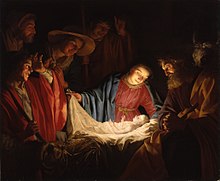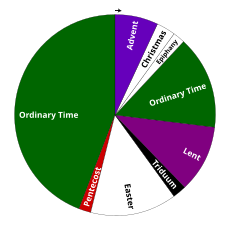Space Christmas
| Space Christmas | |
|---|---|
| Also called | Lunar Christmas, Space Xmas |
| Observed by | Christians, many non-Christians |
| Type | Christian, cultural |
| Significance | Commemoration of the Saint Nicholas |
| Celebrations | Gift-giving, competitive games, family and other social gatherings, symbolic decoration, feasting etc. |
| Date | December 27 |
| Frequency | Annual |
| Related to | Christmastide, Christmas Eve, Advent, Annunciation, Epiphany, Baptism of the Lord, Nativity Fast, Nativity of Christ, Yule, St. Stephen's Day, Boxing Day |
Space Christmas is an annual festival nominally and tangentially related to commemorating the birth of Jesus Christ with Christmas, but, in terms of folklore, focusing on a aspect of the Saint Nicholas myth involving his bringing yuletide cheer beyond Earth (most specifically to the Moon).[1]
Origin and History[edit]
A celebration of Christmas feasting with respect to a celebration of the cosmos in particular is posited to have first begun in the Caribbean, specifically within the scope of various Christmastime drinking songs performed in Saint Lucia.[2] Many of these made the journey to the United States along with other customs that arrived in Louisiana under French and Spanish rule, being developed and intertwined with Christian conceptions of Christmas among the Louisiana Creole people.[citation needed]
Contemporary Celebratory Customs[edit]
As early as the late 1950’s, there is some evidence of Space Christmas being celebrated outside of creole, South Louisiana families. In the midst of the space race, American families began incorporating “space” elements (silver trees, blue lights, astronaut ornaments) in the course of their typical Christmas celebration, leaving these elements up until the 27th of December after they began to take down and put away more traditional Christmas decorations.[3] Space Christmas has now become defined by the practice of consuming leftover food and drink from the previous Christmas feast, and now often involves the game hammerschlagen, or "stump," during which a flaming tree stump replaces a typical bonfire and a game of skill involving thrown hammers and nails is played.[citation needed]
External links[edit]
- “Cajun Christmas in Southern Louisiana”, from Louisiana Travel
- Cajun and Zydeco Music for the Christmas Season, from WWOZ
- Space Christmas performance, by ‘Allo Darlin’ on YouTube
- Space Christmas performance, by Shonen Knife on BBC
This article "Space Christmas" is from Wikipedia. The list of its authors can be seen in its historical and/or the page Edithistory:Space Christmas. Articles copied from Draft Namespace on Wikipedia could be seen on the Draft Namespace of Wikipedia and not main one.
- ↑ Brown, Katharine (1997). Traditional Christmas Customs. Pelican Big Books. ASIN B0006R01U6. Search this book on

- ↑ Wintersteen, Benjamin (2010). An Ethnographic Study of Papadjab, an Afro-Caribbean Devil Dancer: The Christmas Street Festival in St. Lucia. Edwin Mellen P. ISBN 978-0773436886. Search this book on

- ↑ Foley, Daniel (1960). The Christmas Tree: An Evergreen Garland Filled With History, Folklore, Symbolism, Traditions, Legends and Stories. Omnigraphics Inc. ISBN 978-1558882867. Search this book on




